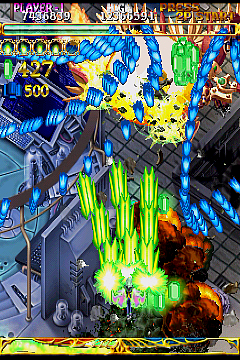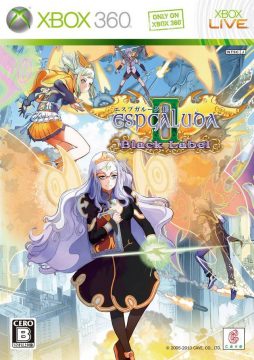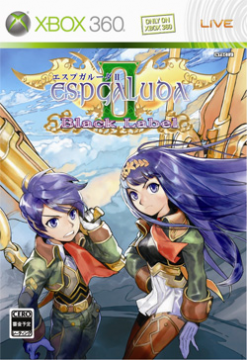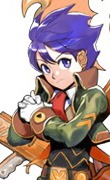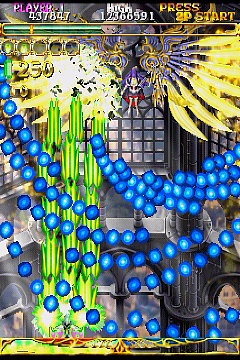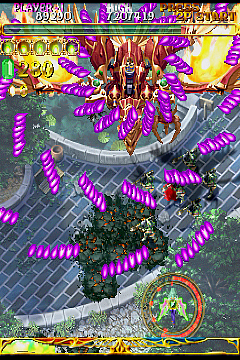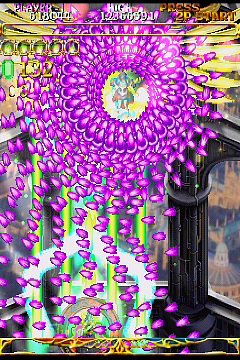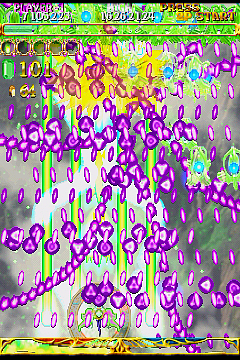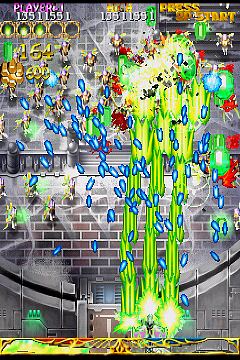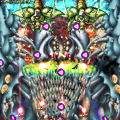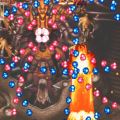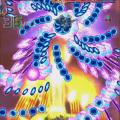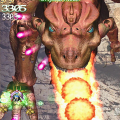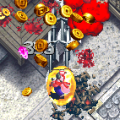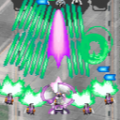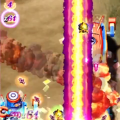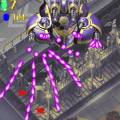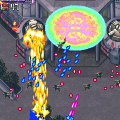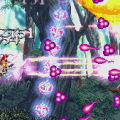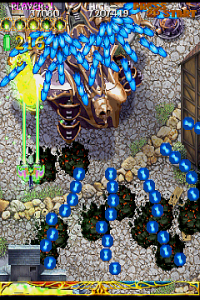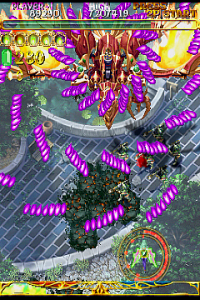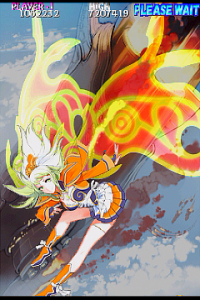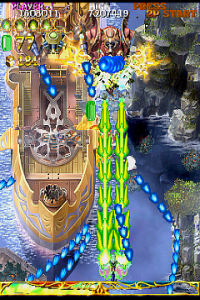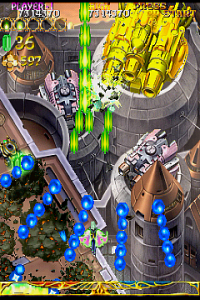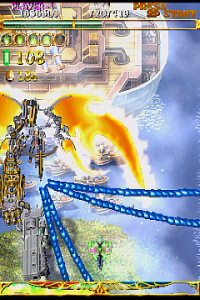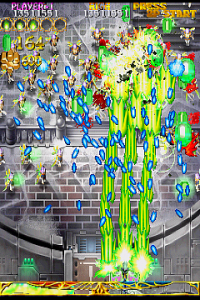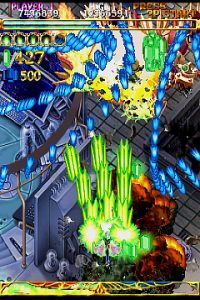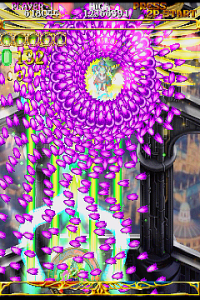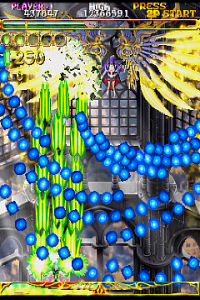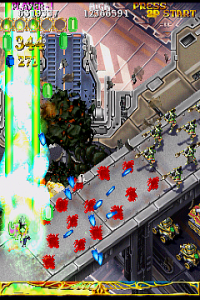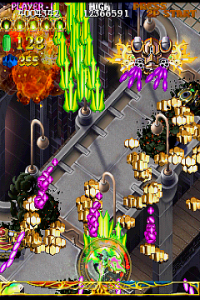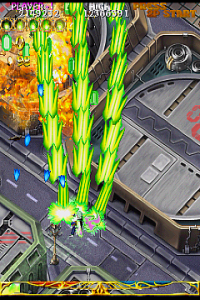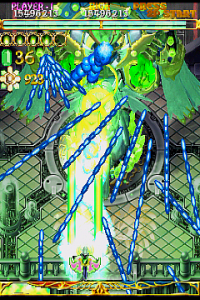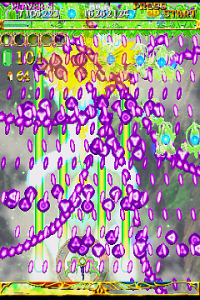Three years after the so-called “Great Shinra War” comes to a close, its impact has yet to fade: the formerly-prosperous nation of Soma, one of the invasion’s targets, still struggles to recover. In the midst of all this, Ageha and Tateha, along with their mother, newly freed from her self-imposed bonds, have retreated into hiding here, hoping to finally obtain some measure of peace for themselves. Little do they know that the country’s researchers have been combing through the wreckage of Jakou’s empire, in search of the secret behind the “spirit engine” – once the device’s inner workings are finally deciphered, Soma’s royal family quickly commences its own quest for military dominance. The children of Project Espgaluda find themselves hunted down once again, and are forced back into battle – this time around, though, they’re not quite so alone.
Characters
Asagi
Soma’s first successfully-produced “Galuda” specimen – shy and sensitive, but also, like many prototypes, dangerous and unpredictable. Deeply disturbed by the suffering that so many test subjects before her had undergone, Asagi violently rejects her creators’ intentions, dealing a deathstroke to the belligerent king in the process – upon fleeing the palace her intuitive powers soon lead her, and the pursuing army, to Ageha and Tateha. Unlike the others her weaponry is weak all around in “normal” mode, but becomes highly potent when “awakened” – with a full set of power-ups she’s the strongest of the bunch. Her name was derived from the Parantica butterfly genus, a subset of the Nymphalidaefamily.
Seseri
Yup, she’s still not dead, thanks to tireless efforts on her behalf by both Soma’s engineers and her real-life fans. Recovered, rebuilt and spoiling for one last(?) fight, Seseri not only gives you another run for your money late in the game, but is finally granted playable status and a full set of Galuda powers in “Black Label” mode. Her “standard” laser array can be widened or narrowed depending on the player’s movement, while her “awakened” form comes equipped with a set of gunpod helpers.
All of the first game’s mechanics have been carried over into the sequel, with a couple of relatively minor and mostly-welcome changes:
1) Your character’s hit area is now visible during gameplay while “focused” or “awakened”.
2) Enemies give up more gems when destroyed with the laser, and/or from close range; how quickly you down them no longer makes a difference.
3) You do not “power down” at all when you die.
4) “Overmode level” growth is not affected by whether or not you’re shooting, and does not reset upon dying.
5) The amount of gold you possess no longer influences boss patterns.
6) A “stage end bonus” dependent on how many gems and gold pieces you’ve collected is awarded at the conclusion of each level.
7) All arcade machines now support a separate “rapid fire” key by default; with the original it had to be hacked in.
Galuda II‘s most substantial adjustment, however, is much more basic, makes itself evident to players almost immediately: on pretty much every front, this game is a far steeper challenge than its predecessor. Enemies and their assaults of neon blue come at you thicker and faster throughout, to the point that you’ll be hard-pressed to make it more than a few stages in without some practice, even with kakusei mode and all of the other “equalizing” tools at your disposal. A one-credit clear is definitely not impossible, but players will have to work much harder to earn their stripes – anybody worried that Cave’s famously sharp edge had dulled can rest easy, though Espgaluda‘s more casual fans might need to schedule therapy sessions (“Why doesn’t IKD love me anymore?”).
This sudden and stinging shift in focus couldn’t have come at a more ironic and somewhat depressing time: even as its target audience is deliberately pruned, Espgaluda II finally nails down how to instantly appeal to outsiders in a way that its precursor failed to. Whether one prefers the original’s cleaner, smoother illustrations to the more ornate, delicate style of new artist/character designer Masaki Hirooka (Castlevania: Order of Ecclesia, Suikoden Tierkreis) is a matter of personal taste, but that Cave has made much better use of these redone assets in bringing the game’s world to life is beyond dispute. The prevailing pseudo-steampunk ambience hasn’t changed much, but the arcade hardware has been upgraded, and more importantly a heretofore-unseen degree of attention has been paid to variety and detail – on the visual front, both sprites (check out the glowing edges on the wings) and backgrounds (note the expanded color palette and multi-directional scrolling) pop out and scream “look over here, this is awesome!” as loud and clear as they should have done the first time around.
Not taking any chances on the musical front either, Cave bring frequent collaborator Manabu Namiki (aka Santaruru) back on board as composer, and invite his fellow Basiscape member Mitsuhiro Kaneda (Tekken 6, Oboro Muramasa) along to lend a hand. The duo complement the game’s graphical improvements with a soundtrack that takes the too-bare electronica framework laid by the first and lends it a clearer and bolder sense of self: individually-insignificant “exotic” touches and accents are applied exactly where they’re needed and come together to make a world of difference, as the reworked thumps, beats, and vamps provide a distinctive, crackling charge to the action which was largely missing before.
Once you’re off and running, Galuda II is simply stuffed to the gills with “wow!” moments that the original, to its detriment, lacked – take the “port” zone, a refreshing change of scenery from the near-uninterrupted town and city locales of Espgaluda. About halfway in you’re accosted by the local mini-boss, a boorish mechanized soldier who shoots off his mouth and his oversized cannon in equal capacity (fans nickname him “Wehha”, after his distinctive laugh) – within moments you’ve demonstrated your power and blown one of his arms clean off, but the assault continues even as blood streams from his side.
After this stubborn adversary finally succumbs to the inevitable (well, not quite – he shows up for a rematch in Stage 4, as a disembodied head grafted onto a super-tank), you find yourself passing above an enormous military carrier – once its anti-air artillery has been blasted away, a series of huge dents, each punctuated by a resounding “clang”, are suddenly punched almost straight through the hull from the inside. Seems your destructive shenanigans have woken somebody up – sure enough, the hulking beast within splinters its makeshift prison and roars hungrily into the sky, a bit earlier than its handlers anticipated. Level 3’s conclusion, on the other hand, takes a more understated approach, but is no less memorable for it – when you see the first stage boss’s battered body cradled in his sobbing sister’s arms, and hear her voice break as she leaves his side and rises to confront you, the first game’s jumbled story montages seem even more ill-conceived in retrospect.
Espgaluda II, however, is more than just a flashier, tougher expansion of Espgaluda (though it certainly is that) – while it’s possible to play through it in largely identical fashion to the original, score attackers have been given a new toy to play with, and its name is “kakusei zetsushikai” (sometimes rendered “zesshikai” – literally, “absolute death field”). Once you’ve built up an ample supply of both gems AND gold, press and hold down the “kakusei” button for a moment: the background will flash and distort as “zetushikai” is enabled. During this state both types of item will gradually drain: if the gold runs dry you’ll simply revert to “regular” kakusei, but once your gems are gone you’ll enter into “overmode”, and if the “auto-bomb” is activated here, you lose your entire bomb energy gauge.
At first, you might wonder why you’d ever bother with zetsushikai: while enemy bullets still move slower, many baddies release more of them than usual, and while killing them cancels the shots out, they do not leave gold in their wake. In fact, dead enemies spawn even more bullets, specifically a nasty missile that homes in on you and respawns ad infinitum after being cancelled. Why would you want so much extra hazardous crap floating around? Here’s why: though disappearing bullets in zetsushikai don’t award gold, they ARE still worth lots of points and governed by a multiplier, though this one goes all the way up to x500. If you can manage to dance around the pulsing mess you create and cancel out the big patterns at just the right moment, your score will positively skyrocket: skilled players can earn enough points for two life extends before reaching the first boss.
Should you choose to brave it, surviving the onslaught brought on by zetsushikai requires substantial effort in most instances, but two key things are worth remembering. First, in later levels your gold actually starts to drain more slowly, making restocking easier the farther you get – second, killing enemies in zetsushikai reduces your gem stock much less than in it does in “regular” kakusei, so you’re free to stay put and rack up the really big multiplier numbers for much longer than would be possible if you were just after gold. Hang tough and you can rock the proverbial house like never before with smart use of zetsushikai; those same wide-eyed onlookers (assuming they’re still following you around) will have even MORE shiny screen-filling bonus numbers to gawk at.
While not nearly as friendly to the uninitiated as its elder sibling, Espgaluda II plays host to notable improvements in just about every other area, and a home port to the surprisingly shmup-friendly XBox 360 was all but inevitable. While its lengthy list of features (myriad screen adjustment options, “Novice” and “Training” modes, tutorials, replay saving/sharing, online co-op and leaderboards) is comparable to that of the oft-praised Mushihime-sama Futari port handled by outside developer M2, Cave (with much of the credit going to development head Makoto Asada) programmed this one itself, and in some ways did an even better job.
“Arcade” mode is very much spot-on, as is the accompanying “360” mode, which optimizes the in-game sprites and artwork (though not stage backgrounds) for HDTVs and fixes a minor bug or two – in case that wasn’t enough, all first-print copies include an original soundtrack CD. “Limited Edition” buyers got different cover art and a decorative faceplate (plus an outer cardboard box to store it all) in exchange for their extra yen, while pre-orders from various Japanese retailers tacked on one of several collectible phone cards. In a rather bizarre twist of fate for overseas fans, Espgaluda II‘s “regular” edition will play on any XBox 360, but the “limited” disc is locked to NTSC-J consoles only: the decision to go regionless was apparently made after the LEs had been printed, so the lockout could only be removed from the other discs, which were produced later. Speaking of “later”, the following year a budget-priced “Platinum Hits” reissue hit shelves; it doesn’t include any bonus stuff, but it’s region-free as well as cheaper. Keep all of this in mind if you’re looking to import.
Some readers might have glimpsed a brief reference to a “Black Label” variation earlier on in the article, or noticed that the full title of the 360 port is, indeed, Espgaluda II Black Label – unusual, considering that there never was a “Black Label” revision in the arcades. No matter – Cave has cooked one up just for console customers, and threw a couple more extras in there while they were at it. Even better, everything is right there on the disc, so there’s no need to pay extra for DLC. Let’s begin with “Black Label” mode itself, which starts off by again remixing the soundtrack (courtesy of Ryu Umemoto) and replacing Asagi with Seseri on the character select screen. Playing “for survival” is a good deal easier here, as downing an enemy in “normal” mode not only earns you gems like usual but cancels its bullets into gold, no kakusei needed. Moreover, to the right of your “barrier” gauge is a new resource, the “shield” meter. When an enemy bullet gets too close to you, “shield” will be expended to temporarily hold it back and prevent it from hitting home. Don’t worry too much about skimping either, as it will gradually refill when not being utilized.
Thanks to these more-forgiving tweaks Black Label is an appealing refuge for players who find the main game too difficult, but bona fide high score chasers also have other layers to sink their teeth into: while consecutively-collected gold can now be multiplied up to 1000 times base worth, this factor is reliant upon a “chain meter” at the top of the screen. As in DoDonPachi and several other Cave productions, bringing down baddies in uninterrupted succession builds the “chain” and allows the items’ value to keep increasing, but if you go too long without a kill and the meter empties you’re back to square one. By the way, since you don’t need kakusei mode to earn gold anymore, what use is it? Glad you asked – the “chain” meter decreases much more slowly while you’re “awakened”, so you’ll want to take advantage of it in sparsely-populated areas.
Also, while enemies don’t produce gold while you’re “awakened”, they do cough up additional bullets, which can be reaped for fun and profit with a quick switch back into “normal” mode. Timely use of zetsushikai can be even more lucrative, as it allows you to “graze” certain enemy shots to split them and multiply their numbers further still: if you’re feeling cheeky, rush headlong into a thick cloud of them until your “shield” meter runs out. Even “overmode” can be exploited in Black Label, as braving those speedy red bullets greatly boosts your damage output, allowing for super-quick boss kills if you can keep up. Granted, Espgaluda II isn’t exactly a “simple” shooter to begin with, and Black Label’s laundry list of changes to the formula can seem even tougher to keep track of at first, but those who do stick with it get to tackle the game’s one-of-a-kind challenges from a whole new angle.
Cave’s second 360-exclusive bonus is “Arrange” mode, the brainchild of Battle Garegga creator Shinobu Yagawa – interestingly, he seems to have drawn inspiration not so much from his own previous rank-centric work as from Treasure’s Ikaruga. Here, enemies shoot either blue or red bullets (or a combination of both) at you: the former can be cancelled into gems with your “regular” shot, while the latter will vanish when hit with your laser. Coupled with the fact that you start with five lives instead of three, Arrange definitely equips its players well, but be advised – every time you change over from your shot to your laser or vice-versa you lose some gems, so volleying back and forth to clear the screen completely is unwise. Kakusei and zetsushikai work pretty much the same as in the “regular” game, except that you can stock up to 1000 gems – oh, and “overmode” is now the easiest state to fall back on in tight situations, since running out of gems changes all enemy shots to a distinctive dark red color, which can be cancelled with either of your weapons. All in all Arrange mode isn’t as exciting a diversion as Black Label, but it’s not a bad change of pace from time to time.
While you won’t see it on the main menu at first, there’s still one more selection to go: once you’ve cleared the game once in any capacity (even the simplified “Novice” variations) “Omake” mode (literally “extra”, “bonus” or “freebie”) is unlocked. In Omake, whenever you collect either gems OR gold, a “combined counter” displayed at the top of the screen will climb higher – boosting this number is the key to high scores, so your goal should be to greedily snap up as much raw stuff as possible. There are several ways to speed up this process: for one thing, notice that when enemy shots pass close enough to your character, they turn red. Switching into or out of kakusei mode will make these red bullets disappear, but destroying any onscreen enemy instead will transform them into gems: essentially, try to be in the thick of it as much as possible when making kills, sort of like the Shikigami no Shiro series.
You can also abuse your “guard barrier” to amass gems, but it can’t be activated manually – instead, you’ll always “auto-bomb” when hit, even in “normal” mode, and it’ll cost barely any meter. Once this happens you can hold the “bomb” button down and milk enemy bullets for gems; if your meter gets low, amass a full stock of 1,000 gold and it will be automatically exchanged for a refill of up to half your barrier. Deciding where and when to do this is key, since saving up and maintaining a full stock of gems, gold, and guard barrier earns additional rewards from targets – kakusei, however, should be used sparingly, since switching into it drains the overall counter (zetsushikai has been disabled entirely). Rather wacky stuff, but if you’re able to wrap your head around the other modes this one shouldn’t be much more difficult to get a bead on.
A mere two months after the 360 port hit shelves, Cave surprised a lot of people by releasing Espgaluda II yet again, this time onto Apple’s ever-expanding “i” lineup of devices, the company’s first venture into the budding platform. While nothing below a third-generation iPod Touch, iPhone 3GS or iPad can run the game (iOS 4.1 or higher for the former two, iOS 4.2 for the iPad), it’s a pretty impressive conversion: both the appearance and feel of this handheld edition are about as close to the original as one could reasonably expect, especially considering the reduced price point (according to Cave’s Mobile Content Department, which handled this version, some viewers of the first in-game preview footage thought it was a cruel April Fool’s joke). A small area at the bottom of the screen is set aside for controlling character movement directly with your finger: which of the three play options (“Simplified”, “Normal”, or “Expert”) you choose determines how many other actions (shot on/off, shot change, kakusei, and barrier) are activated manually via onscreen “buttons”, or else handled automatically.
Arcade mode is present, of course, as is an exclusive “iPhone Mode” – both feature three difficulty levels, “Novice”, “Normal”, and “Hard” (though the labels are a bit misleading: “Hard” actually features bullet patterns closest to the original arcade version’s defaults, while the others are easier). The latter mode sets itself apart with the new “awakening pulse” technique – when you activate kakusei your character can no longer move, but touching any onscreen bullets with your finger will cancel them into gems, while tapping minor enemies directly snuffs them out and cancels all their shots at once. The longer you stay “awakened” the higher your multiplier goes, so once it’s topped out wait for a big fat screenful of bullets before switching back to convert the whole mess into gold. There’s a bit more depth to this setup than is immediately apparent – quick-fingered players can manipulate certain situations to cash in on gold and recharge their multiplier in one fell swoop.
“iGaluda” has received updates to render it compatible with OpenFeint and Game Center, allowing you to share scores and achievements with others – all regions have access to it (and a free demo) on the iTunes store, so if you’re not altogether opposed to shmupping on this sort of newfangled gizmo there’s no reason not to give it a whirl. In late 2011 Cave gave its more tech-savvy customers a new trinket to show off, putting out a graphically-upgraded (and pricier, though it also has a free “lite” trial version) “HD” edition of Espgaluda II exclusively for the iPad 2 – aside from the visuals it’s pretty much the same as its little brother, except for a new arranged soundtrack (by Kenichiro Fukui and KAY) for “Smartphone” mode. At the same time, those still using older iDevices were granted a permanent price cut for the “regular” version of the game, an update which adds in the new arranged music, and the option to buy the “Arcade” and “Smartphone” modes separately갷wait, you might ask, didn’t you say before that the second mode was called “iPhone mode”? Yes, it was – right up until Cave finally threw Android gamers a bone a month or two later and made Espgaluda IIavailable on the Android store as well, first in Asia and then in the West. The game makes the transition capably, though it utilizes a “rendering skip” feature to enable smoother performance on the new device.
Back in Japan-exclusive territory, i-mode cell phones also have a port of Espgaluda II available, though it’s obviously not as full-featured as the other editions. Additional merchandise is a bit scarce compared to some of its more accessible cousins, but fans with spare cash can seek out the official soundtrack (containing two discs: one original, one remixed) and the official DVD set (three discs, one for each character’s superplay run, plus an 80-page book featuring additional tips, artwork, staff commentary and other information). The “Black Label” musical arrangements on the 360 also rated their own separate album if you just can’t get enough of those funky beats.
Links:
Cave Official developer site (Japanese)
Arika PS2 port official page (Japanese)
The World of Espgaluda Translation at gamengai.com
Interview: Cave Mobile division interview at Next-Gen
Official Cave Twitter (English)
cave-db Fan site with various information
